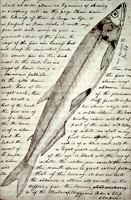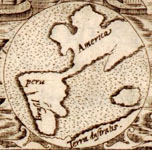Curator of Historic Interiors
Emily Roberts, assistant curator of historic interiors at Colonial Williamsburg, talks about the research involved in furnishing and re-outfitting rooms according to colonial practices.
Emily Roberts, assistant curator of historic interiors at Colonial Williamsburg, talks about the research involved in furnishing and re-outfitting rooms according to colonial practices.
Todd Norris, manager of performing arts at Colonial Williamsburg, talks about colonial theatrical performances and Colonial Williamsburg's presentation of Othello.
Note: this podcast is no longer available. To view a transcript of the original podcast, click here.
Paul Aron, author of We Hold These Truths, discusses examples of famous American rhetoric, particularly dating from the American Revolution.
Historian Cathy Hellier explains the differences between modern American English and the English of the colonists during the 1700s; she looks also at new ideas on the dialect of African Americans in the Williamsburg area at the time. Click here to learn more about 18th century speech.
Naturalist Mark Catesby (1683-1749) studied and made watercolors of the wildlife and plants of colonial America. Interpreter Robb Warren talks about the man and his art.
Bill Barker, a Jefferson scholar and interpreter at Colonial Williamsburg, discusses the political philosophy of Thomas Jefferson, in relation to the launch of a new blog publishing Jefferson quotes on the Colonial Williamsburg website.
Note: this podcast is no longer available. To view a transcript of the original podcast, click here.
Colonial Williamsburg public sites interpreter Alex Clark details the effect of Thomas Paine's pamphlet "Common Sense" on the American colonies.

These published works, manuscripts, images, and motion picture footage address the formation of the movement to conserve and protect America's natural heritage. Materials include 62 books and pamphlets, 140 Federal statutes and Congressional resolutions, 34 additional legislative documents, and excerpts from the Congressional Globe and the Congressional Record. An additional 360 presidential proclamations, 170 prints and photographs, two historic manuscripts, and two motion pictures are available.
Materials include Alfred Bierstadt paintings, period travel literature, a photographic record of Yosemite, and Congressional acts regarding conservation and the establishment of national parks. An annotated chronology discusses events in the development of the conservation movement with links to pertinent documents and images.

This well-designed site presents the Nebraska edition of the Lewis and Clark journals, edited by Gary E. Moulton. The site provides the complete text of all the journals from the 18031806 expedition, as well as introductions, prefaces, and sources. The material is searchable by keyword and phrase.
There are 29 scholarly essays about the expedition. An image gallery offers 124 images of pages from the journals, 95 images of people and places, and 50 images of plants and animals encountered on the expedition. The maps section includes 12 explanatory maps and nine images of maps from the journals. Additionally, there are 27 audio excerpts of journal readings and eight video interviews with the editor of the project. The website stands as an outstanding resource for researching the history of the Lewis and Clark expedition.

This large collection of maps from the 16th century to the present day focuses on Americana and cartographic treasures.
Materials are organized into seven thematic categories—Cities and Towns, Conservation and Environment, Discovery and Exploration, Cultural Landscapes, Military Battles and Campaigns, Transportation and Communication, and General Maps. Sections include five special presentations.
Users may download maps or zoom in to view details. Seventeen specific map collections contained within this larger site that are of particular importance for the study of American history include "Discovery and Exploration," "The American Revolution and Its Era," "Railroad Maps, 18281900," "American Colonization Society Collection: Maps of Liberia, 18301870," "Panoramic Maps, 18471929," "Civil War Maps," and "Mapping the National Parks."